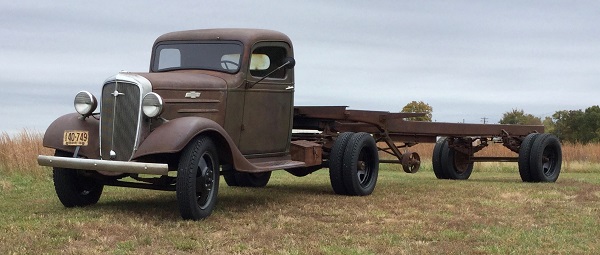

This subject came to the surface recently by a customer, Jake LaRose of Maynard, Iowa. He had purchased an outer door skin for his 1936 Chevy ½ ton however the fit was just not quite correct, close but not right! Jake was at a loss! We immediately began to research for an answer to his dilemma.
The answer was discovered after so much research and locating people with these pre-war trucks.
The answer was that 1936 is a split year between the low and high cab designs. The doors did look the same, however, we found a fraction of an inch prevents a high cab door sheet metal patch panel from fitting on a low cab door frame!
With this unusual data discovered, it only seems appropriate to place the findings in writing for the few that may be stumped with this part of their 80 year old Chevy truck restoration.
The 1934 through mid-1936 Chevy truck doors were equipped with three hinges. The difference here is that the 1934-35 years had doors supported by a wood frame. The outer sheet metal skin was tacked to the wood. As long as the wood held up from deterioration, they closed very well. (This door construction was the method used even on Chevrolet’s first trucks in 1918)
Problem: The wood in most trucks setting outside was effected by morning dew and many rains each year. As time went on, door sagging and thus worn hinges and latches, became common.
GM designers in 1934 and 1935 were aware of what would usually occur to the current doors on new trucks based on those of prior years. Therefore, the decision was made not to wait for the coming late 1936 high cab design to improve on the wood frame design. The Great Depression was underway and new truck and car sales were very slow. GM improvements like eliminating wood frames in door construction for longer life was hoped to add more sales by hesitant buyers of these large high ticket items.
Thus, an unusual change (near the end of the high cab era) was introduced at the beginning of the 1936 year. Though the actual cab construction remained the older wood frame with a metal skin tacked over. Doors in early 1936 changed with sides and interior supports made of stamped sheet metal.
Their three door hinges required a slight modification. The hinge half that attached to the front cab door post were unchanged (this vertical door support remained wood) however the hinge half that attached the new metal door frame used holes designed for fasteners that secured to metal.
In summary: If you are under a major restoration of an early 1936 Chevrolet truck, be sure you do not purchase late 1936 door sheet metal repair skins. They will not fit!
As of this writing, early 1936 door skins are not available, however bids are currently being requested from several skilled metal workers to create a limited number of these handmade skins!
IMPORTANT SUMMARY:
What is so unique about the above text? The dimensions of the new metal door skins on the 1936 high cab with metal frames remained the same as the 1934-35 with wood frames.

High cab - early 1936 Low cab - late 1936


